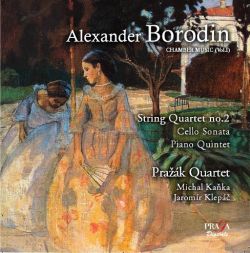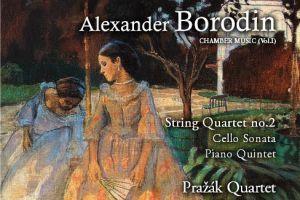
This is a disc that presents, at first glance, a small puzzle. It’s presented as Volume I of a complete traversal of Alexander Borodin’s chamber music on the Praga label, but Volume II of the series already exists — has, in fact, been available for the past five years. What’s going on here?
I don’t know why release of these recordings was delayed so long (the sessions themselves were in 1999 and 2000), but it’s obvious enough why this has to be called Volume I, whatever the order of release: It contains the Second Quartet. If Borodin — eminent chemist, enthusiastic amateur cellist, and gifted if occasionally erratic composer — is known to the listening public by any single work, it’s probably his Polovetsian Dances, but the D-Major Quartet runs a close second. Full of luscious tunes (particularly for the cellist), with a rapturous Notturno at its heart, it was beloved among quartet players and audiences alike long before a couple of its tunes made their way into the Wright/Forrest musical Kismet.
Listen To The Music
Cello Sonata in B minor, III. Maestoso - presto (excerpt)Piano Quintet in C minor, II. Scherzo (excerpt)
Purchase Recording

A portion of each purchase helps
support San Francisco Classical Voice
Recordings are legion, of course, and some of them are quasi-legendary among quartet fans. I grew up with the eponymous Borodin Quartet’s later recording (Melodiya, licensed by EMI), and love also the Hollywood Quartet’s classic one (what a gift the piece is to a cellist like Eleanor Aller!). By comparison with those two performances, the Pražák Quartet’s take is lighter, fleeter, more delicately textured. There is something almost Mendelssohnian in the mien. There’s no lack of expressivity — indeed, in places is heard a delightfully flexible, subtle inflection that the others sometimes miss in their richness and density of tone. On the cake-to-fudge scale, the Pražáks are definitely well toward the former.
But even if you prefer your sweets dense (I confess that I still haven’t gotten used to the brisk tempo of the Pražáks’ Notturno), if you’re interested in Borodin at all, you’re likely going to want to hear this disc, because the other two works on it are much rarer on disc and in concert. Both were published posthumously. The 1860 B-Minor Cello Sonata, indeed, saw publication only in 1982, after musicologist Michael Goldstein reconstructed it from the incomplete manuscript (we aren’t told how incomplete). The C-Minor Piano Quintet of 1862 made it to print in 1938.
The Sonata, played here by Pražák cellist Michal Kaňka and pianist Jaromír Klepáč, will startle any violinist at first hearing, because the piece opens with the fugue subject of Bach’s G-minor solo sonata. The motif returns in the finale, first as portentous introduction and then transformed into a vivacious, lightly dancing romp. (One of those characteristically juicy Borodinian tunes serves as the second theme.) Between the two comes a pensive Pastorale whose Russian-folk-melody–inflected middle culminates in a long cello cadenza.
Borodin wrote this for himself to play; he must have been no mean cellist. It’s puzzling that more cellists haven’t taken it up. True, there’s a bit of sprawl (as there is in much early Borodin) and a certain quantity of earnest counterpoint (ditto), yet the attractions, to my ear, more than compensate.
The Quintet, from two years later, has many of the same merits and defects. Again, there are three movements, but this time the central one is a scherzo, one that feints at being a fugue but keeps slipping the contrapuntal leash for more leisurely and tuneful territory. Its central section, much slower, has much of the feel of the Andante first movement, with the same five-note ornaments decorating the melodic lines and the same occasional modal tinges that suggest, once more, folk melody. The finale, longer than the first two movements put together, has a bit of a grab-bag aspect. There’s a lot of material in here, and many unexpected turns, not least the last: After appearing two or three times to be tensing its haunches for a spring to a joyously triumphant conclusion, it draws back and ends in a serene hush. The Pražáks and Klepáč give it their considerable all, especially the pianist, who I suspect has to contend in places with a part more awkward to play than he makes it sound.
There must be at least a Volume III to come from Praga. There are two short movements for string quartet (one of them an entirely delightful scherzo in 5/8 time), an incomplete string sextet, an incomplete piano trio, and at least one string trio. The notes to this disc also mention, tantalizingly, a quartet for the odd combination of flute, oboe, viola, and cello that I’ve never heard mentioned before. Let’s hope we needn’t wait another five years.

